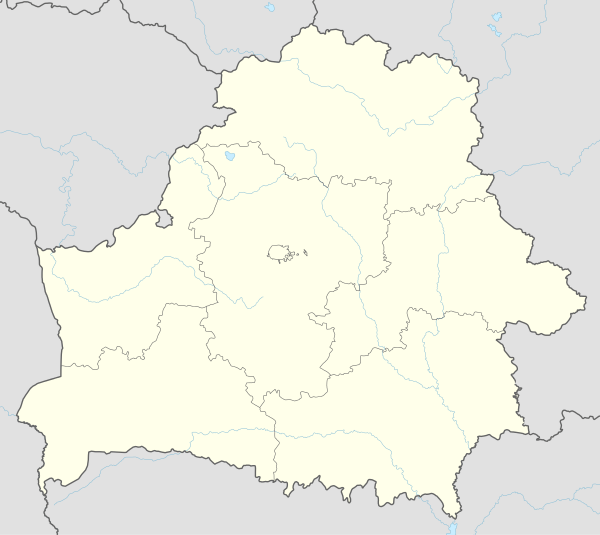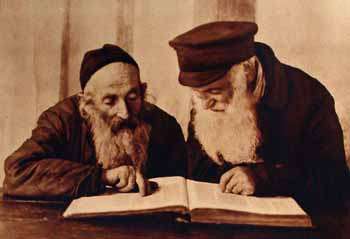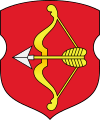Pinsk
Pinsk
| |||
|---|---|---|---|
.jpg) | |||
| |||
 Pinsk Location of Pinsk in Belarus | |||
| Coordinates: 52°07′N 26°06′E / 52.117°N 26.100°E | |||
| Country |
| ||
| Region | Brest Region | ||
| District | Pinsk District | ||
| Mentioned | 1097 | ||
| Area | |||
| • Total | 51.48 km2 (19.88 sq mi) | ||
| Elevation | 141 m (463 ft) | ||
| Population (2013) | |||
| • Total |
136,096 | ||
| [1] | |||
| Time zone | UTC+3 (FET) | ||
| Postal code | 225700, 225710, 225716, 225745 | ||
| Area code(s) | +375 165 | ||
| License plate | 1 | ||
| Website | Official website | ||
Pinsk (Belarusian: Пі́нск, Pinsk; Russian: Пи́нск; Ukrainian: Пи́нськ, Pyns'k; Polish: Pińsk; Yiddish/Hebrew: פינסק, Lithuanian: Pinskas) is a city in Belarus, in the Polesia region, traversed by the river Pina, at the confluence of the Pina and Pripyat rivers. The region was known as the Marsh of Pinsk. It lies south-west of Minsk. The population is about 138,202.
The historic city has a restored city centre full of two-story buildings dating from the 19th century and the beginning of the 20th century. The city centre has become an active place for youth of all ages with summer theme parks and a newly built association football stadium that houses the town's football team, FC Volna Pinsk.
History
Pinsk is first mentioned in the chronicles of 1097 as Pinesk, a town belonging to Sviatopolk of Turov. The name is derived from the river Pina. Pinsk's early history is closely linked with the history of Turov. Until the mid-12th century Pinsk was the seat of Sviatopolk's descendants, but a cadet line of the same family established their own seat at Pinsk after the Mongol invasion of Rus in 1239.
The Pinsk principality had an important strategic location, between the principalities of Navahrudak and Halych-Volynia, which fought each other for other Ruthenian territories. Pinsk did not take part in this struggle, although it was inclined towards the princes of Novaharodak, which is shown by the fact that the future prince of Novaharodak and Vaišvilkas of Lithuania spent some time in Pinsk.
In 1320 Pinsk was won by the rulers of Navahrudak, who incorporated it into their state, known as the Grand Duchy of Lithuania. From this time on Pinsk was ruled by Gedimin's eldest son, Narymunt. Afterwards, for the next two centuries the city had different rulers.
In 1581 Pinsk was granted the Magdeburg rights by the Polish king, and in 1569 – after the union of Lithuania with the Crown of the Polish Kingdom – it became the seat of the province of Brest within the Polish-Lithuanian Commonwealth.
From 1633 on Pinsk had a secondary school, the so-called brothers' school (the brotherhoods were religious organisations aiming to provide education for their members and their children). During the Cossack rebellion of Bohdan Khmelnytsky (1640) against Polish king John II Casimir, it was captured by Cossacks who carried out a pogrom against the city's Jewish population; the Polish Army retook the city with considerable loss of life. Eight years later the town was burned by the Russians.
In 1648, on the eve of the Russo-Polish War (1654–1667), Pinsk was occupied by Ukrainian Cossack army under commander Niababy and could only be reconquered with great difficulty by Polish prince Janusz Radziwiłł, a high-ranking commander in the Polish-Lithuanian army. During the war between Moscow and the Polish-Lithuanian Commonwealth (1654–1667) the city suffered heavily from the attacks of the Muscovite army under Prince Volkolnsky and its allied army of Ukrainian Cossacks.
Charles XII took it in 1706, and burned the town with its suburbs. In spite of all the wars the city recovered and the town developed with the existence of a printing workshop in Pinsk from 1729 to 1744. Pinsk fell to the Russian Empire in 1793 in the Second Partition of Poland. It was an uyezd center in Minsk Governorate except brief occupation by Napoleon in 1812.
20th century
Pinsk was occupied by the German Empire on 15 September 1915 during the First World War. After the German defeat, Pinsk became the subject of dispute between the short-lived Belarusian People's Republic and Ukrainian People's Republic. Pinsk was taken over by the advancing Red Army on 25 January 1919 during the Soviet westward offensive of 1918–19. It was retaken by the Polish troops on 5 March 1919 during the Polish–Soviet War, than regained by the Red Army on 23 July 1920, and finally taken over by Polish Army on 26 September 1920. Pińsk became part of the reborn sovereign Poland in 1920 at the time when the Polish-Soviet War was coming to an end with the Peace of Riga signed in March 1921.[2]

Like many cities in Eastern Europe, Pinsk had a significant Jewish population before World War II and the Holocaust. According to the Russian census of 1897, out of the total number of 28,400 inhabitants, Jews constituted approximately 74 percent of the population (or 21,100 persons), making it one of the most Jewish cities under the Tsarist rule.[3] During the Polish-Soviet War of liberation, in April 1919, thirty-five Jews from Pinsk were executed by the Polish Army under the charge of being the Bolshevik collaborators who fired at the Polish soldiers. The incident, known as the Pinsk massacre, created a diplomatic crisis noted at the Versailles Conference.[4]
World wars
Pińsk was initially a provincial capital of the Polish Polesie Voivodeship. The civic centre was moved to Brześć-nad-Bugiem (now Brest, Belarus) after the city-wide fire of 7 September 1921. The population of Pińsk grew rapidly in the interwar Poland from 23,497 in 1921 to 33,500 in 1931. Pińsk was a bustling commercial centre with 70 percent of the population being Jewish in spite of considerable migration.[5][6] During the Soviet invasion of Poland, on 20 September 1939 Pinsk and the surrounding territories were occupied by the Red Army of the Soviet Union in accordance with the Hitler-Stalin pact against Poland that started World War II.
Following Operation Barbarossa, from 4 July 1941 to 14 July 1944, Pinsk was occupied by Nazi Germany as part of Reichskommissariat Ukraine. Most of the Jews were killed in late October 1942, during the liquidation of the Pińsk Ghetto by the German Ordnungspolizei and the Belarusian Auxiliary Police.[4] Ten thousand were murdered in one day. In 1945 with the new post–World War II border adjustments of Poland, Pinsk became part of the Belarusian Soviet Socialist Republic. It was the center of Pinsk Oblast between 1939 and 1941 and again between 1944 and 1954 before joining the Brest Voblast. Pinsk has been part of the Republic of Belarus since its independence from the Soviet Union in 1991.
Landmarks
Three main sights of the town are lined along the river. These are the Assumption Cathedral of the monastery of the greyfriars (1712–1730) with a campanile from 1817, the Jesuit collegium (1635–1648), a large Mannerist complex, whose cathedral was demolished after World War II by communists, and the Butrymowicz Palace (1784–1790), built for Mateusz Butrymowicz, an important political and economical figure of Pinsk and Polesie. The church of St. Charles Borromeo (1770—1782) and St. Barbara Cathedral of the monastery of the St. Bernard order (1786–1787) are placed near historic center in the former Karolin suburb (now part of Pinsk). The foremost among modern buildings is the black-domed Orthodox cathedral of St. Theodore.
_(2).jpg) Old Market Square
Old Market Square.jpg) Cathedral of St. Stanislaus and church of St. Dominic
Cathedral of St. Stanislaus and church of St. Dominic- Cathedral of Name of the Blessed Virgin Mary
- Monastery of the Greyfriars
 Jesuit collegium
Jesuit collegium- Church of St. Charles Borromeo
- St. Barbara Cathedral
 St. Theodore Cathedral
St. Theodore Cathedral Butrymowicz Palace
Butrymowicz Palace
Climate
| Climate data for Pinsk | |||||||||||||
|---|---|---|---|---|---|---|---|---|---|---|---|---|---|
| Month | Jan | Feb | Mar | Apr | May | Jun | Jul | Aug | Sep | Oct | Nov | Dec | Year |
| Record high °C (°F) | 10 (50) |
16 (61) |
21 (70) |
25 (77) |
30 (86) |
30 (86) |
32 (90) |
31 (88) |
28 (82) |
23 (73) |
14 (57) |
12 (54) |
32 (90) |
| Average high °C (°F) | −1 (30) |
−1 (30) |
4 (39) |
11 (52) |
18 (64) |
20 (68) |
22 (72) |
22 (72) |
17 (63) |
11 (52) |
3 (37) |
0 (32) |
11 (51) |
| Daily mean °C (°F) | −5.3 (22.5) |
−4.3 (24.3) |
−0.2 (31.6) |
7.2 (45) |
13.8 (56.8) |
16.9 (62.4) |
18.3 (64.9) |
17.2 (63) |
12.9 (55.2) |
7.1 (44.8) |
1.7 (35.1) |
−2.8 (27) |
6.9 (44.4) |
| Average low °C (°F) | −6 (21) |
−6 (21) |
−2 (28) |
3 (37) |
8 (46) |
11 (52) |
12 (54) |
12 (54) |
8 (46) |
3 (37) |
0 (32) |
−3 (27) |
3 (38) |
| Record low °C (°F) | −30 (−22) |
−24 (−11) |
−23 (−9) |
−10 (14) |
−2 (28) |
2 (36) |
6 (43) |
2 (36) |
−3 (27) |
−11 (12) |
−17 (1) |
−25 (−13) |
−30 (−22) |
| Average precipitation mm (inches) | 34 (1.34) |
32 (1.26) |
33 (1.3) |
44 (1.73) |
57 (2.24) |
74 (2.91) |
85 (3.35) |
69 (2.72) |
53 (2.09) |
49 (1.93) |
45 (1.77) |
42 (1.65) |
617 (24.29) |
| Source: [7] | |||||||||||||
Notable residents
- Bona Sforza, (1494-1557), Queen consort of Poland and Grand Duchess consort of Lithuania, Princess of Pinsk
- Adam Naruszewicz (1733–1796), Polish-Lithuanian poet, historian, bishop
- Matheus Butrymowicz (1745-1814), Polish-Lithuanian statesman, reformer of Polesye
- Aaron of Pinsk (died 1841), rabbi
- Napoleon Orda (1807-1883), Polish-Lithuanian musician, pianist, composer and artist
- Vintsent Dunin-Martsinkyevich, (1808-1884), Belarusian writer, poet, dramatist and social activist, author of play "Pinskaya shlyakhta"
- Helena Skirmunt (1827-1874), Polesian painter and sculptor
- Baruch Epstein (1860–1941), bookkeeper, rabbi and prolific Jewish scholar, best known for his Torah Temimah commentary on the Old Testament (Torah)
- Ivan Zholtovsky (1867-1959), Soviet architect and educator
- Raman Skirmunt (1868-1939), Belarusian and Polesian statesman, aristocrat and landlord
- Chaim Weizmann (1874–1952), first president of Israel, born in Motal, near Pinsk and educated in Pinsk
- Sir Isaac Shoenberg (1880–1963), electrical engineer born in Pinsk, principal inventor of the first high-definition television system, as used by the BBC
- Leo Zeitlin (1884–1930), composer, born in Pinsk before studying in Odessa and later moving to the U.S.A.
- Golda Meir (1898–1978), fourth prime minister of Israel, born in Kiev, lived two years of her childhood in Pinsk
- Simon Kuznets (1901–1985), 1971 Nobel laureate in economics
- Theodore Odrach (1912-1964), Ukrainian and Polesian writer of novels, short stories and memoirs
- Kazimierz Świątek (1914-2011), Cardinal of the Roman Catholic Church, Metropolitan Archbishop of Minsk-Mohilev and Apostolic Administrator of Pinsk
- Semyon Furman (1920–1978), Chess grandmaster and trainer of World Champion Anatoly Karpov
- Ryszard Kapuściński (1932–2007), Polish writer and reporter
- Yauhen Shatokhin (1947-2012), Belarusian painter and political activist
- Chaim Kanievsky (1928–), rabbi
- Izya Shlosberg (1950–), Jewish American artist, born in Pinsk and lived in Pinsk for 44 years
- William Moses Feldman, child physiologist, born in Pinsk
- parents of Ralph Lauren, American fashion designer lived in Pinsk before moving to the U.S.A
- Vladimir Chub (1948–), governor of Rostov Oblast in Russia
- Igor Kolb (1977?–), principal dancer of Mariinsky Ballet
- Olga Govortsova, (1988–) Belarusian tennis player
- Andrzej Kondratiuk (1936–2016), Polish film director, screenwriter, actor, and cinematographer
References
- ↑ "Belarus - The regions of the Republic of Belarus as well as all cities and urban settlements of more than 10,000 inhabitants". City Population. Retrieved 2014-04-11.
- ↑ Norman Davies (2003). White Eagle, Red Star: the Polish-Soviet War, 1919–20. Pimlico. p. 399. ISBN 0-7126-0694-7. (First edition: New York, St. Martin's Press, inc., 1972.)
- ↑ Joshua D. Zimmerman (2004), Poles, Jews, and the Politics of Nationality. University of Wisconsin Press, ISBN 0-299-19464-7, Google Books preview, p. 16.
- 1 2 Best of the memory books, Marcin Wodzinski, Haaretz, Books, February 2009, pp. 28–30
- ↑ PAT MF.271 (1936). "Original film footage: "In the land of rivers and bogs" newsreel chronicle" [W krainie rzek i moczarów]. Sygnatura: MF.271 Data wydania: 1936. Czas trwania: 00:01:16.
- ↑ Cezary Rudziński (2017). "History of Pinsk in the Borderlands" [Pińsk. O dziejach kresowego miasta]. Otwarty Przewodnik Krajoznawczy.
- ↑ weatherbase.com—http://www.weatherbase.com/weather/weather.php3?s=91033]. Retrieved 29 November 2017.
Further reading
- Mordechai Nadav (2008) The Jews of Pinsk, 1506–1880; edited by Mark Jay Mirsky and Moshe Rosman; translated by Moshe Rosman and Faigie Tropper. Stanford, Calif: Stanford University Press,
- (in Belarusian, Russian and English) T. A. Khvagina (2007) Pinsk and its surroundings, Minsk Vysheysha shkola, ISBN 978-985-06-1419-3,
- (in Belarusian, Russian and English) T. A. Khvagina (2004) Pinsk: A Fairy Tale of Polessye, Minsk Vysheysha shkola, ISBN 985-06-0836-6,
- (in Belarusian, Russian and English) T. A. Khvagina (2005) POLESYE from the Bug to the Ubort, Minsk Vysheysha shkola, ISBN 985-06-1153-7.
External links
| Wikimedia Commons has media related to Pinsk. |
- Yad Yisroel - Pinsk
- Jewish Community in Pinsk on Virtual Shtetl
- Photos on Radzima.org
- "The city of Pinsk, Belarus" by Tatyana Khvagina and Oleg Babinets
- Unofficial site of Pinsk
- "Pinsk", Jewish Encyclopedia
- Images of the Assumption Cathedral
- Image of the Jesuit Collegium
- Virtual Guide to Belarus: Pinsk
- News from Pinsk
- Pinsk, Belarus at JewishGen


